Need help deciding whether Apple or Google has the right music streaming service for you? Then keep reading. Apple Music launched in 2015 and was a relative latecomer to the streaming services market, but Apple's continual development of the platform has made it into one of the most popular choices for enjoying digital music. Google's music strategy on the other hand has been confusing in recent years. The company's original service, Google Play Music, has been rolled into YouTube Music, so that's what we'll look at here.

Google Music
Google launched its original Play Music streaming service in 2011. Like Apple Music, Play Music gave you access to a vast music library, music recommendations, radio stations, and offline listening, all for a monthly fee. In a unique contribution to the streaming services field, Google Play Music also let all Google account holders (i.e. not just subscribers) upload up to 50,000 tracks from their existing music library to the cloud, for storage and online streaming.
In May 2017, Google launched an on-demand ad-supported music streaming service called YouTube Music, shortly followed by YouTube Music Premium – a revamped version of its ad-free YouTube Red subscription service with a renewed focus on original programming. The rebranded service includes personalized playlists, intelligent search, support for background playback on mobile and music downloads for offline listening. It also offers access to remixes, covers and live versions that aren't available on other platforms. YouTube Music has replaced Google Play Music, and existing subscribers have had their playlists, collections, and preferences migrated automatically.
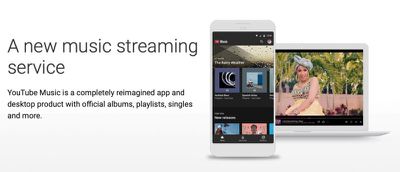
Subscriptions and Plans
An individual Apple Music subscription costs $9.99 per month in the United States, with slight price variations in other countries and territories. Membership means you can stream Apple's music catalog, download music and videos for offline listening, and get exclusive access to new releases and exclusives, as well as a back catalog of shows broadcast on Apple's Beats 1 radio station.
A standard YouTube Music subscription also costs $9.99 per month. That gets you access to Google's music catalog, music recommendations, radio stations, offline listening, and access to YouTube Music Premium, which has the same features as YouTube Premium such as background listening and video downloads, but with those features locked to the YouTube Music service only. An Apple Music student subscription costs $4.99 and requires you to sign up using your educational institution credentials. YouTube Music doesn't appear to offer an equivalent plan, although eligible students can subscribe to YouTube Music Premium for $4.99 a month.
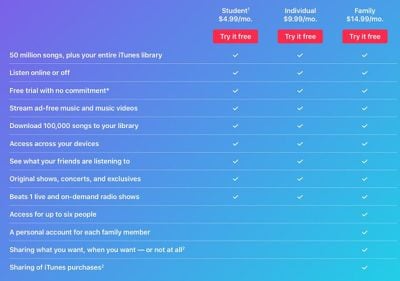
Apple Music's family plan costs $14.99 a month and allows up to six people to access the services using a personal account for each family member. Members can also share iTunes purchases with each other in addition to catalog content, but all family members must use the same credit card for App Store/iTunes purchases. Google also offers a $14.99 a month YouTube Music Family Plan. When you subscribe to the family plan, you and up to 5 family members can stream music on up to 10 devices each and share eligible purchased items on YouTube using Family Library. (Each family member still has separate Google Accounts, playlists, libraries, and offline content.)
Both Apple Music and YouTube Music memberships automatically renew each month, but you can cancel renewal at any time and your subscription will run out at the end of your current billing cycle.
Free Trials
Apple Music offers a free three-month trial of its paid service, which converts to a paid membership unless the user cancels before the trial period is over.
Google offers all users a free three-month trial of YouTube Music, which is probably the best way to get a taster of what Google's music streaming service offers.
Libraries and Offline Listening
All paid Apple Music and YouTube Music plans give you access to a huge catalog of songs songs when you sign up. Apple Music boasts 50 million songs in its catalog, while YouTube Music subscribers get the pick of 40 million songs, so regardless of which one has the most content, both allow you to build up a large collection of music.
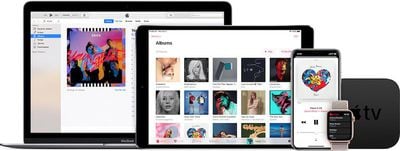
Apple Music users can download a maximum of 100,000 songs to their library, and thanks to Apple's iCloud Music Library feature these can be synced across devices signed in to the same Apple ID. YouTube Music users can download as many songs, albums, and playlists as they want for offline listening (Google doesn't specify a maximum number).
Streaming quality
Starting in June 2021, Apple Music will support Spatial Audio and Lossless Audio, two features that are being provided to Apple Music subscribers at no additional cost. Both of these features will significantly improve the Apple Music listening experience.
Spatial Audio with Dolby Atmos will provide an immersive, multi-dimensional audio experience that allows artists to mix music in a way that makes it sound like the notes are coming from all around you. Apple has had a Spatial Audio feature available for television content, and now it is expanding to Apple Music audio content.
Apple is upgrading its entire music catalog to Lossless Audio with the ALAC (Apple Lossless Audio Codec) that preserves the details in the original audio file. Apple Music subscribers will be able to hear songs exactly as the artists recorded them in the studio.
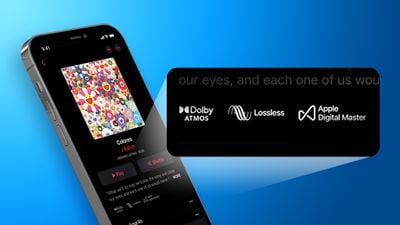
When Lossless Audio launches, 20 million songs will support the codec, with all 75 million songs available in Lossless Audio by the end of 2021.
The standard Lossless tier will start at CD quality, which is 16-bit at 44.1 kHz, and it goes up to 24 bit at 48 kHz. There's also a Hi-Res Lossless tier available at 24 bit 192 kHz, but Hi-Res Lossless requires an external digital-to-analog converter (DAC).
If you don't opt to use Apple's lossless tiers, Apple Music streams 256kbps AAC files across the board, while Google Play Music users can select the streaming bitrate from low (198 kbps), normal (192 kbps), and high (320 kbps AAC) quality. YouTube Music currently appears to have a maximum bitrate of 128 kbps, but that's likely to improve in time.
Apart from audiophiles, most listeners probably won't notice much difference between the highest quality streams of the same song, but YouTube Music's option to select the bitrate can come in handy if you're worried about using up your cellular data.
Mobile, Desktop, and Web Apps
The Apple Music catalog is accessed from within the Music app, which has a clean white interface and comes pre-installed on every iPhone, iPad and iPod touch, and also is available as a separate downloadable app on Android devices. The mobile app is organized into tabs to access your music library, browse the Apple Music catalog, and listen to radio stations, while a "For You" tab lets you check out recommendations based on your listening preferences.

The YouTube Music app, available on both iOS and Android, has a similar clean interface, but a more minimalist feel to it, with tabs for accessing the YouTube Music catalog, your own music library, recently played content, and recommended listening.
Both apps are easy to navigate and include fullscreen media players that showcase album art as you listen. These screens also put add-to-playlist, sharing, song queuing, and audio device options at your fingertips. Users familiar with Gmail and other apps by Google should feel right at home in the YouTube Music app, although Apple's Music app has the advantage of Force Touch support on compatible devices, which can be used to quickly access additional menus.
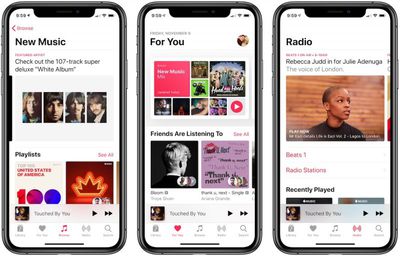
Both apps allow you to add any existing music you own to your library, but offer different routes to achieving this. YouTube Music lets you sync up to 50,000 tracks from your computer using an upload client app or the web player, after which they become available for streaming from any device signed into your Google account. Apple Music uses iCloud Music Library to match any songs you have in iTunes to tracks in the Apple Music catalog, which are then made available on your other devices.
Apple Music in iTunes (available for PC and Mac) is largely based on the same format as the mobile app, but it's not quite as pretty. It's also a little less navigable, but it does have one trick up its sleeve: Smart Playlists. These can be automatically generated by iTunes based on genre, date added, loved/disliked, and so on, meaning you don't have to manually build playlists yourself if you don't want to. Apple doesn't offer a native player for web browsers, though third-party workaround service Musish lets you listen to Apple Music on the web.
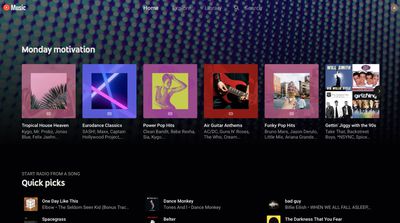
YouTube Music can be played through browsers on your Mac or PC.
Discovery Features
When you sign up for Apple Music, Apple asks you to select some of your favorite artists so that the service can get a sense of your tastes. Using this information, Apple Music populates its regularly updated "For You" section with new releases, daily mixes and playlists to appeal to your preferences. Playlists can take on a style (pop or jazz, for example), a particular artist, or even a particular activity like studying.
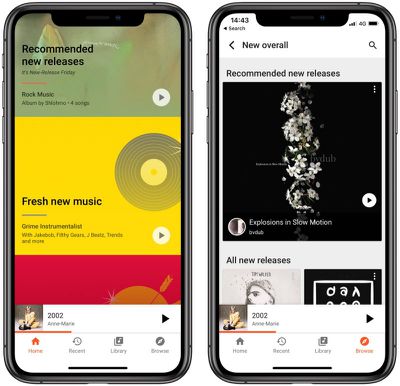
Discovering new music isn't as straightforward in YouTube Music, especially when you first sign up. However, the Home tab soon starts to populate with personal album and playlist recommendations after you've spent some time liking/disliking songs in the media player, and if you sync existing music to your library, Google will use this to get a better idea of your tastes.
While YouTube Music's Home tab also features new releases and "Made for everyone" playlists categorized into genres and moods/activities, Apple Music's non-personalized content lives in a separate Browse tab showcasing trending artists and playlists, top charts, and music videos. Browse is also home to a TV and films section that features Apple-made programming like Carpool Karaoke and artist documentaries (Apple is currently investing heavily in programming, so expect more content to appear here in the coming months).
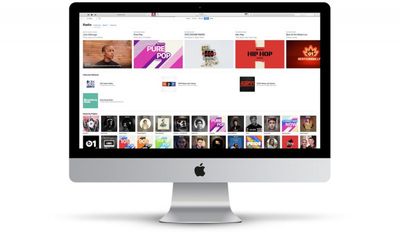
Apple Music's Radio tab features curated music stations tuned to your listening habits as well as Apple's Beats 1 radio station. Beats 1 offers live radio 24 hours a day, and also plays a big part in the platform's music discovery. The Radio tab also has an archive of its most popular radio shows and playlists from years past.
YouTube Music sideloads its Radio offering in the Browse tab under various categories including genres, activities, moods, and decades. The UI presentation is a little dull, but listening to YouTube Music's stations is probably the best way to encounter new content on the platform that you might like, and the more thumbs up/thumbs down you give to songs, the better Google's algorithms are at generating new music recommendations for you.
Music Sharing
Apple Music allows you to follow friends who are also subscribers and share playlists with them that you've personally created. Apple Music's For You tab will also show you what your friends are listening to if you've connected to them.
YouTube Music has no such social features, but it does let you share song links via text or over social media.
Speakers and Voice Assistants
As an Apple Music subscriber, you can use Siri as a personal DJ to control song playback, queue up songs, find song facts, add songs to your library, play your favorite playlists, or even play something new. This is a big advantage Apple Music has over YouTube Music, which requires a more complicated solution through Siri Shortcuts, and even then, it lacks many equivalent features.
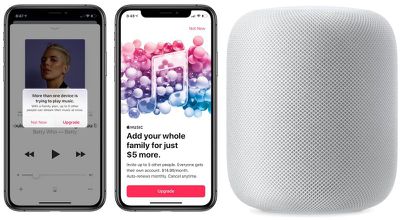
Apple's HomePod speaker is essentially made to be used in conjunction with Apple Music. In fact, one of the main uses for Siri on HomePod is to control your Apple Music collection. There are Siri voice commands for accessing content like playlists, genres, moods, liking or disliking songs, playing more music based on something you've heard, starting a new radio station, and much more. None of these functions will work with a YouTube Music subscription. You can stream audio to HomePod from a device running the YouTube Music app, but that's it.
If you own a Google Home speaker though, you're in luck. As you'd expect, Google's smart speakers fully integrate with YouTube Music, so you can invoke Google's voice assistant to carry out many of the same spoken commands mentioned above. Apple Music is not available as an integrated option on Google Home devices.
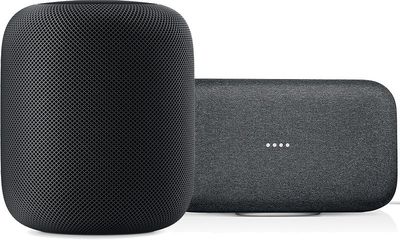
In addition, you can combine YouTube Music with the Google Assistant mobile app. When you do, YouTube Music combines your preferences with real-time information — like location, weather, and more — so that its voice assistant can recommend the right music for what you're doing, how you're feeling, or what you want to hear. However this does involve allowing Google access to a raft of privacy permissions on your mobile device, so you may want to think twice before you enable them.
Listening in the Car
Apple's CarPlay system supports Google Play Music and, of course, Apple Music. If a car doesn't have CarPlay, most newer models have their own entertainment systems, which often make it easy to connect your chosen streaming service. Usually you can do so either direct from a built-in app, over Bluetooth, or via a cable connection. You can also listen to Apple Music and Play Music music through your phone's or car's speakers with Android Auto.
Apple Music highlights
- Seamless integration with Apple's eco-system
- Beats live radio and archive
- Human curated recommendations
- Social features
- Support for uploading/matching your own music files
- Works natively with HomePod
YouTube Music highlights
- Cloud storage for existing music library
- Official web player
- Excellent music suggestion algorithms
- Minimalist mobile UI
Summing Up
When Google Play Music migrated to YouTube Music, all of Play Music's features survived the transition, and YouTube Music is a good choice if you own Android devices and you're already a heavy user of Google and YouTube apps and services.
On the other hand, if you're invested in the Apple ecosystem (perhaps you own an Apple TV or a HomePod as well as an iPhone) then Apple Music is the clear winner. Apple's service is quicker off the mark with its music suggestions, offers a better user experience in the mobile app, and includes some neat social features, where YouTube Music virtually has none.








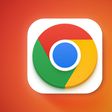












Top Rated Comments
I used it for a solid 4 years until Apple Music was released. My main complaint with GPM, back then, was the mobile interface. I absolutely hate that zoomed in album art view and downloads on iOS take forever, you also can't download in the background on iOS. Google then started taking some things away. You can no longer look at new released per genre, just new releases as a whole. You also can't browe by genre. I remember the "new music Friday" (used to be new music Tuesday) section being a lot bigger but now it just recommends 6 things instead of the 20 or so albums/singles it used to recommend.
Then there's YouTube Music. I like YouTube Music's mobile interface better. The dark theme, the way the album art is displayed, I even like how the colors of the controls section change to match the album art. But it's still a buggy mess. I would be willing to wait for Google to fix it but theres one major problem they need to fix first before I can do that: the 5000 song playlist cap. GPM has a 1000 song cap for manually created playlists but the Thumbs Up playlist (the only one I really care about) is unlimited. Even now, my Thumbs Up playlist is sitting at 10970 songs. I still have GPM because I subscribe to YouTube Unlimited, the student version is $6/month and comes with everything.
If Google gets their acts together and gives YTM all the features of GPM (including the ability to upload missing tracks), removes the playlist song cap, and adds CarPlay, I might think about unsubscribing from Apple Music.
I like Amazon Prime Unlimited but they took away the ability to upload missing tracks. Their library seems to be lacking some big name bands (at least in the genres I listen to). Tool is one of them though they haven't digitally released their music. But Amazon is also missing Rammstein, Mushroomhead, and some pretty common soundtracks. Without being able to upload the missing content, Amazon is a no-go for me. They used to let customers pay $25 a year to upload up to 100,000 songs (or maybe even more), you could upload 250 songs for free. But they stopped that service and just want people to stream from Amazon's catalog.
Apple Music lacks all the obscure EDM that I love